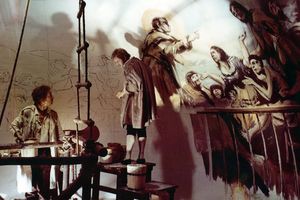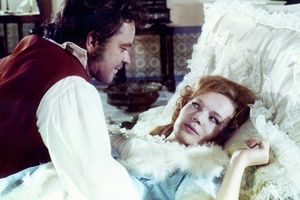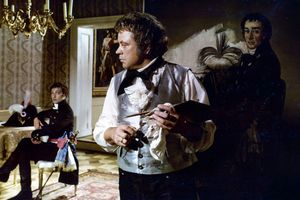Goya
Director: Konrad Wolf, 134 Min., Color, Feature Film
Deutsche Demokratische Republik (DDR); Sowjetunion
DEFA-Studio für Spielfilme / Lenfilm, 1971
- Film/Video Format
- 70 mm
- Length in m
- 3662
- Other Title
- Goya - oder der arge Weg der Erkenntnis
- English Title
- Goya
- Premiere Date
- Release Date (for Cinema)
- Literary Source
- Feuchtwanger, Lion: "Goya oder Der arge Weg der Erkenntnis", Roman
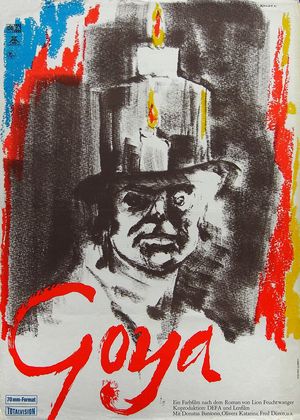
(Dir.: Konrad Wolf, 1971) Graphic Design: Werner Klemke
Short Summary (English)
Francisco de Goya, the court painter of Charles IV and Maria Luisa, the Catholic King and Queen of Spain, was an affluent and highly respected man who deserved to be regarded as an eminent painter of major importance.
His art work adorned the galleries and castles of some of the richest families in Spain. But Goya was a man of the people, and the contradiction that he had to face between his feelings of solidarity with the lot of the common people on the one hand, and loyalty to the Spanish crown on the other, is something that had become an increasing source of personal discontent. Goya not only realized how the Royal Spanish Court had become a place of intrigue for unscrupulous ministers, but also his country's catastrophic economic and social situation and, moreover, Goya reasoned that the reverberations of the French Revolution would barely find an echo in his native Spain.
Goya's closest assistant and most trusted friend, Augustin Esteve, brought him in touch with Spain's genuine patriots.
Among them, singer Maria Rosario who had been the first to plead innocent before the Inquisition Tribunal. What hinders Goya's arduous enlightenment process is his passionate relationship to the most beautiful, but wholly complicated, Duchess de Alba.
At this point, however, the painter has become far too socially committed to close his eyes to the truth and deny the voice of his inner convictions. Uncompromisingly, the artist places his work in the service of an unadulterated and honest representation of reality.
Source: Progress Film-Verleih
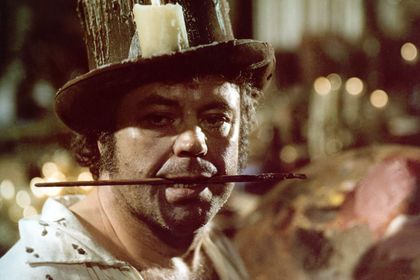
(Dir.: Konrad Wolf, 1971) Photography: Arkadi Sager
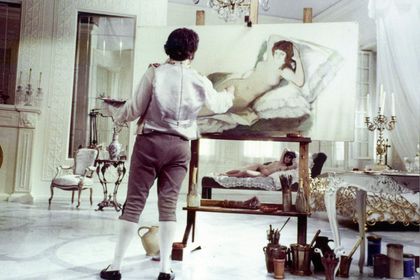
(Dir.: Konrad Wolf, 1971) Photography: Arkadi Sager
Film Crew
- Director
- Script
- Scenario
-
- Angel Wagenstein
- Camera
-
- Werner Bergmann
- Konstantin Ryshow
- Peter Hellmich (Dokumentaraufnahmen)
- Film Editing
-
- Alexandra Borowskaja
- Cast
-
- Donatas Banionis (Goya)
- Olivera Vuco (Pseudonym: Olivera Katarina) (Herzogin Alba)
- Fred Düren (Esteve)
- Tatjana Lolowa (Königin Maria Luisa)
- Rolf Hoppe (Karl IV.)
- Mieczyslaw Voit (Großinquisitor)
- Ernst Busch (Jovellanos)
- Gustaw Holoubek (Bermudez)
- Wolfgang Kieling (Godoy)
- Michail Kasakow (Guillemardet)
- Iren Sütö (Dona Lucia)
- Andrzej Szalawski (Abate)
- Martin Flörchinger (Otero)
- Arno Wyzniewski (Quintana)
- Carmen Herold (Maria Rosario)
- Ljudmila Tschursina (Pepa)
- Peter Slabakow (Gil)
- Weriko Andshaparidse (Goyas Mutter)
- Ariadna Schengelaja (Josepha)
- Nunuta Hodos (Euphemia)
- Georgi Pawlow (Padilla)
- Igor Wassiljew (San Adrian)
- Günter Schubert (Ortiz)
- Kurt Radeke (Velasco)
- Walter Bechstein (Bote der Inquisition)
- Fredy Barten (Don Antonio)
- Slobodan Dimitrijevic (Student)
- Igor Dmitrijew (Don José)
- Michael Gerber (Sekretär der Inquisition)
- Djordje Rosic (El Incognito)
- Friedrich Richter (Alter Priester)
- Erhard John (Vorsitzender des Tribunals)
- Harald Moszdorf (Hofmeister)
- Peter Grünstein (Ferdinand)
- Maria Lenk (Maria Josepha)
- Herbert Pfister (Prinz Louis von Parma)
- Regine Kühn (Maria Louisa von Parma)
- Ralf Haufe (Don Carlos (Kind))
- Elke Boßmann (Maria Isabell (Kind))
- René Kasch (Don Francisco de Paola (Kind))
- Frank Raschke (Xavier (Kind))
- Gerit Kling (Elenita (Kind))
- Hansjoachim Felber (Sterbepriester)
- Ljudmila Wolynskaja (Conchita)
- Georgi Teich (De Havre)
- Aleksej Sokolowitsch (Majordomo)
- Shana Jeremjejewna (Genivieve)
- Karl-Heinz Weiß (Inquisitor)
- Predrag Milinković (Lebemann)
- Antun Nalis (Geschäftsmann)
- Natasa Nesovic (Alte Frau)
- Petar Spajic (Balladensänger)
- Aurora Pan
- Spanisches Ensemble "Fiesta Gitana da Silva"
- Assistant Director
-
- Doris Borkmann (Assistenz-Regie)
- Wladimir Stepanow (Assistenz-Regie)
- Iris Gusner
- Jürgen Klauß
- Ludmila Galba
- Wladimir Sinilo
- Emilija Suchorukowa
- Assistant Camera
-
- Genadi Nesterjenko
- Anatoli Rodionow
- Production Design
-
- Alfred Hirschmeier
- Waleri Jurkewitsch
- Script Editing
-
- Walter Janka
- Alexander Dymschitz
- Music
-
- Kara Karajew
- Faradsh Karajew
- Paco Ibanez (Lieder der Rosario)
- Sound
-
- Eduard Wanunz
- Jakob Haron
- Werner Klein
- Musical Performance
-
- Carmen Herold (Gesang Maria Rosario)
- Paco Ibanez (Gitarre)
- Costume Design
-
- Ludmila Schildknecht
- Joachim Dittrich
- Make-Up
-
- Günter Hermstein
- Galina Wassiljewa
- Inge Merten
- Jürgen Holzapfel
- Ursula Funk
- Eduard Fischer (Plastische Masken)
- Production Management
-
- Herbert Ehler
- Genrich Chochlow
- Unit Production Management
-
- Horst Schmidt
- Felix Eskin
- Werner Teichmann
- Alexej Gussjew
- Wiktor Paschtschenko
- Design
-
- Alfred Born (Kunstmaler (Kopien Gemälde, Handzeichungen))
- Julián Celada (Fotografisches Material Spanien)
- Consulting
-
- Karl-Heinz Barck
- Hansjoachim Felber
- Irina Lewina
- Dawid Prizker
- Carmen Herold (Spanische Folklore)
- DEFA Photography
-
- Arkadi Sager
- Dubbing (Director)
-
- Johannes Knittel
- Dubbing (Author)
-
- Annette Ihnen
- Dubbing (Dubbing Actor)
-
- Kurt Böwe (Goya)
- Annemone Haase (Herzogin Alba)
- Ursula Braun (Königin Maria Luisa)
- Gerry Wolff (Großinquisitor)
- Wolfgang Lohse (Bermudez)
- Hans-Dieter Leinhos (Godoy)
- Klaus Piontek (Guillemardet)
- Gisela Rimpler (Dona Lucia)
- Wolfgang Greese (Abate)
- Sonja Kehler (Maria Rosario)
- Marylu Poolman (Pepa)
- Walter Wickenhauser (Gil)
- Else Wolz (Goyas Mutter)
- Barbara Adolph (Josepha)
- Gertrud (auch: Trude) Bechmann (Eufemia)
- Siegfried Seibt (Padilla)
- Manfred Wagner (San Adrian)
- Joachim Siebenschuh (Student)
- Hans-Ulrich Lauffer (Vorsitzender des Tribunals)
- Michael Herbst (Ferdinand)
- Beate Ohloff (Elenita (Kind))
- Adolf Peter Hoffmann (Majordomo)
- Eckhard Bilz (Lebemann)
- Günther Polensen (Geschäftsmann)
- Trude Brentina (Alte Frau)
- Hans Hardt-Hardtloff (Balladensänger)
- Hans Ohloff (Tröstender Priester)
- Dorit Warmuth (Dame)
- Christoph Lau (Bursche)
- Renate Rennhack (Spanierin)
- Fred Delmare (Schmuggler)
- Dubbing (Sound)
-
- Tilo Kreisel
- Dubbing (Editing)
-
- Brigitte Hein
Awards
- Nationalpreis I. Klasse (1971): Nationalpreis I. Klasse - Konrad Wolf
- Nationalpreis I. Klasse (1971): Nationalpreis I. Klasse - Werner Bergmann
- Nationalpreis I. Klasse (1971): Nationalpreis I. Klasse - Konstantin Ryshow
- Nationalpreis I. Klasse (1971): Nationalpreis I. Klasse - Wladimir Sinilo
- Kunstpreis der DDR (1971): Kunstpreis der DDR - Donatas Banionis
- Kunstpreis der DDR (1971): Kunstpreis der DDR - Rolf Hoppe
- Kunstpreis der DDR (1971): Kunstpreis der DDR - Fred Düren
- VII. Internationale Filmfestspiele Moskau (1971): Spezialpreis der Jury
Short Summary (German)
Ausgehend von der literarischen Vorlage, dem Roman von Lion Feuchtwanger, zeigt Regisseur Konrad Wolf den Künstler Goya als einen Mann des Widerspruchs, der zwischen Königstreue und Volksverbundenheit, zwischen ehelicher Treue und seiner Leidenschaft zu Herzogin Alba wankt. Die Schicksalsbegegnung mit der Sängerin Maria Rosario verändert sein Leben.
Als Hofmaler Karls IV. von Spanien ist Don Francisco de Goya y Lucientes zu Ansehen und Wohlstand gekommen. Seine Gemälde zieren die Galerien der Schlösser. In leidenschaftlicher Liebe fühlt er sich zu der Herzogin Alba hingezogen, und gleichzeitig hasst er die hochnäsige Aristokratin in ihr. Er glaubt an den König und die Kirche, genießt seine Stellung bei Hofe. Doch er ist durch und durch Spanier und liebt das Volk. Dieser Widerspruch bringt ihn auf den "argen Weg der Erkenntnis". Sein Mitarbeiter und Freund Esteve führt ihn zu den wahren Patrioten des Landes. In einer Madrider Taverne begegnet er der Sängerin Maria Rosario, später muss er miterleben, wie sie von der Inquisition verurteilt wird. Von dem Lied, das Maria als Beweis ihrer Schuld vortragen muss, ist er tief erschüttert. Je weiter er in das Leben des Volkes eindringt, daraus Motive für seine Kunst schöpft, desto größer wird seine innere Pein angesichts der Zustände im Land. Seine Kunst wird zum adäquaten Ausdruck der revolutionären Bewegung des Volkes. So gerät er selbst in die Fänge der Inquisition. Aber er schwört der Wahrheit seiner Bilder nicht ab und wählt das Exil.
(Quelle: Das zweite Leben der Filmstadt Babelsberg. DEFA-Spielfilme 1946-1992)
Short Summary (Other Languages)
Fresque inspirée du livre de Lion Feuchtwanger sur la vie du peintre. Une réflexion sur les rapports entre pouvoir et art. (Französisch: Cinémathèque française 2003)
Don Francisco de Goya y Lucientes es Pintor de Palacio de su Majestad Catolica Carlos IV y de Maria Luisa de España. El puede alimentar bien su familia, disfruta de comida, música, y mujeres bonitas.
Como buen creyente español él reza, al igual que todos los de la calle, fervientamente a la Virgin, que es paseada en una vistosa procesión. El Palacio, Goya juega un papel pequeño, en recepciones se le da saludo como último, es por eso que el disfruta los pocos momentos de poder, que tiene - cuando le toca poner en formación a la familia Bourbon para realizer un retrato de grupo. Los ojos de Goya estan siempre a la busqueda de impressiones, abiertos a todas las luces y colores de la vida española. Su cículo de amigos le familiariza con las ideas liberales. El exitoso pinter de complaciantes sujetos agudiza los sentidos en favor del destino de su país cayendo sin querer en la Política. La creencia en la bendición del Rey por parte de Dios y en la Santidad de la Iglesia esta profundamente arraigda en el. Por cierto, el pinta lo que ve, es así como el cae en el cículo de personas que la Inquisición vigila. Ella le envía un primer mensajero. Sus advertencias aumentan amenazadoramente. Goya se enamora de la duquesa Alba, que en Español personifica los mas noble de la conciencia nacional. Despuses de un tiempo de mucha felicidad, un amor entre antípodas, se quiebra la relación cayendo Goya en una intensa depresión. Quedo sordo, le torturan visiones, de las cuales trata de liberarse pintando cuadros audaces. Tiene que escapar a Francia. El Gran Inquisidor, que a venido personalmente a buscarlo, encuentra en la case de Goya los heréticos cuardos por todos lados, en las paredes, en el suelo. Es el ultimo desafío de Goya. El Gran Inquisidor lo sentencia al olvido eterno. «El sea maldecido! Maldecido y olvidado para la eternidad!» (Spanisch: Konrad Wolf Retro, Goethe Institut 1992)
Rifacendosi al romanzo di Lion Feuchtwanger, il regista Konrad Wolf porta sullo schermo la vita di Goya, ricco e famoso pittore alla corte di Carlo IV di Spagna e uomo dalle tante contraddizioni. Benché si senta attratto dalla Duchessa de Alba, non sopporta il suo fare aristocratico e snob. Crede nel Re e nella Chiesa, ma si sente anche profondamente spagnolo e ama il popolo. Grazie all'amico e collega Esteve, Goya incontra i veri patrioti spagnoli e la cantante Maria Rosario, successivamente condannata dalla Santa Inquisizione. Il popolo diventa così fonte d'ispirazione per il suo lavoro, che a sua volta diventa forma espressiva della rivoluzione popolare. Goya stesso finirà davanti all'Inquisizione e pur di non rinnegare la veridicità dei suoi quadri, sceglierà di vivere in esilio.(italienisch)

